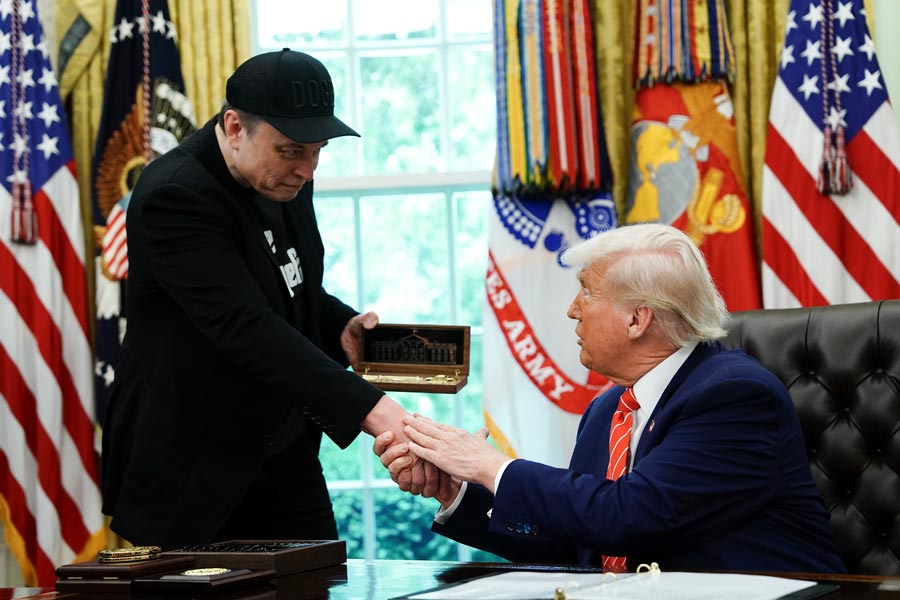Zoological specimensdating back to more than a century and enzymes, chemicals and laboratory equipment worth over Rs 2 crore are feared lost in a fire that coursed through Calcutta University's Ballygunge campus on Monday evening.
The fire, first noticed in a lift and the first-floor laboratory of the zoology department at 5.45pm, quickly spread to the museum adjacent to it, charring exhibits collected since 1914 by teachers and students of Ballygunge Science College.
University officials couldn't immediately assess the loss in terms of money but zoology professor Ena Ray Banerjee, who is in charge of the museum, said the university had lost some priceless specimens.
The Ballygunge campus also houses the biochemistry, biotechnology and microbiology departments.
Urmi Chatterji, associate professor of zoology, said chemicals worth Rs 2 crore might have been destroyed in the blaze. "It is possible that the damage to the laboratory alone would account for more than Rs 2 crore in losses. There are refrigerators with cooling capacities of -20 degrees to -80 degrees Celsius in many of the laboratories across the building. Some chemicals get damaged even if there is a one-degree difference in temperature. Even if the flames didn't reach the refrigerators kept in the other laboratories, the power outage following the fire would have destroyed many chemicals," she told Metro.
Chatterji had developed the cancer research laboratory over a decade and has eight post-doctoral students working with her.
The zoology department has 14 teachers, each of them assigned an independent laboratory. In the event of an emergency, a teacher is allowed to work in another laboratory.
Hundreds of students, research scholars and teachers were in the eight-storey Ballygunge Circular Road building on Monday evening when the fire raged through the first floor and reached the museum adjoining the laboratory where associate professor Chatterji works.
Smoke and a mixture of toxic gases crept up to the fifth floor in the absence of a proper fire-prevention system, catching many of the students and their teachers unawares.
Students and teachers on the third, fourth, fifth and seventh floors realised that a fire had broken out in the building more than half an hour after the first sparks turned into leaping flames, sources said.
Some of those trapped inside exited through the rear and took a ladder down to safety. A group of students were rescued from the terrace by firefighters. Another group broke open a second-floor window and stood on the cornice before being helped down.
Professor Banerjee, who had catalogued the zoological exhibits since taking charge of the museum in 2009, said the hall contained 4,000-odd specimens. She fears some of the rarer specimens, many of them more than 100 years old, such as the Leopard Seal from Antarctica, the South Asian River Dolphin, the Platypus from Australia, and Marmoset and Pangolin from Central and South America have been lost.
"British teachers had once taught here and they took the trouble of collecting the specimens from the Natural History Museum in London. I have yet to see what the fire damaged, but if the specimens I have mentioned are lost then I would say that CU has lost a rare heritage," she said.
According to the zoology professor, the collection includes plenty of surprises - among them a "Mammoth Hair" collected by Biswamoy Biswas (a member of a 16-week Abominable Snowman Expedition to the Himalayas in 1954), a "Glass Sponge" (a primitive unicellular organism) retrieved from an ocean bed and stuffed red pandas and pangolins (both on the red list of threatened species).
Ballygunge Science College, housed in philanthropist Tarak Nath Palit's home, was one of the two campuses with which the University College of Science and Technology had come into existence.
The college opened in 1914 with three departments: zoology, botany and anthropology. Since it was the hub of scientific research, many students, teachers and researchers were encouraged to explore and collect zoological specimens for the institution.
This legacy was strengthened by the likes of T.N. Annandale, the zoologist and anthropologist who started the Zoological Survey of India (ZSI) in 1916.
"He had travelled extensively all over the British colonies, gathering specimens. While most of his personal finds were housed in the Indian Museum and the ZSI, many of those came to Ballygunge Science College, too. It was his efforts and that of the teachers from Britain that helped the museum gain eminence," a veteran professor said.
Banerjee said the museum was an invaluable source of information for anyone involved in zoological research. "Just by scanning the skin of a stuffed specimen, one can determine the food habits of the animal and how it might have died about 100 years ago. Basically, it tells the story of a younger earth. For any researcher, this is a rare insight."
Since the UGC imposed restrictions on dissection of animals in laboratories a few years ago, specimens kept in the museum were used by students of other institutions for reference on a regular basis, said Madhusudan Das, a former head of the department.
A research scholar who was on the campus at the time of the fire said the university was about to enter into a tie-up with the Natural History Museum in London for better upkeep of the specimens.
Vice-chancellor Sugata Marjit said classes had been suspended on Tuesday because of the fire.












